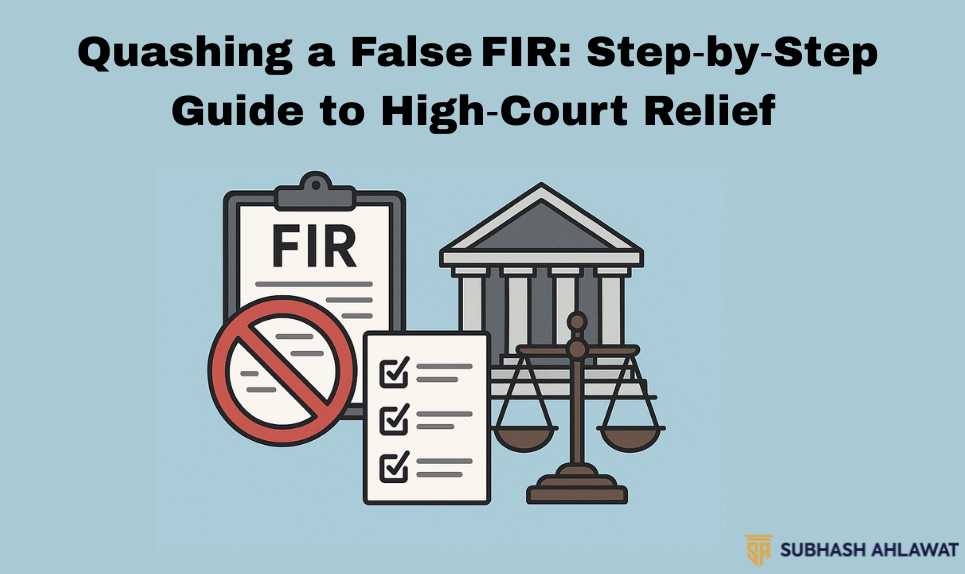Quashing a False FIR: Step‑by‑Step Guide to High‑Court Relief

Sometimes a false or malicious FIR is lodged against a person. This can lead to not only mental stress but also arrest, bail, court dates and even social stigma. Section 528 of the Indian Civil Security Code (BNSS), 2023, gives the high court inherent power to “ensure justice” and prevent “abuse of process”. This blog will give you step-by-step guidance on what practical steps should be taken to question a false FIR.
What is FIR?
The First Information Report is the first information received by the police about any cognizable offence.
This is a formal initiative to start an investigation.
It is the duty of the police to register a case (Lalita Kumari v. State of Uttar Pradesh & Others, 2014).
Note: Quashing of FIR means a complete stop to the investigation, chargesheet and trial - if the High Court is convinced that the FIR is based on stale facts, malicious intent or non-offence.
How to Identify a False FIR?
Alibi/Documentary evidence: Were you at a different location at the time of the alleged incident?
No prima facie offence: Are the essential elements of the offence missing in the complaint?
Civil disputes are given a criminal colour: Property, matrimonial, business contract disputes are often clubbed under Bharatiya Nyaya Sanhita (BNS) offences like cheating, criminal breach of trust etc.
Delay and motive: FIR lodged very late + complainant appears to have personal animosity.
The agreement has already been reached: The parties have signed the agreement, yet it is still ongoing.
What does “Quashing” mean?
“To Quash” = The FIR, chargesheet and related criminal proceedings were quashed as if they never existed. The High Court safeguards the “objectives of justice” by using its inherent powers.
Important Precedent: State of Haryana vs Bhajan Lal (1992) – It listed 7 categories where the FIR can be questioned.
Jurisdiction: Where to File?
The High Court of the State registered the FIR.
Title of Petition: “Criminal Miscellaneous (Quashing) Petition under Section 528 BNSS.”
2 Respondents: State + Original Complainant.
Complete Step‑by‑Step Process
Step 1: Prepare the Evidence Pack
Certified FIR copy (u/s 176 BNSS).
All supporting documents: CCTV, Call logs, GPS, E-mails, Whatsapp chats (printout + Section 63 of the Bharatiya Sakshya Adhiniyam (BSA) affidavit for electronic records).Affidavits given by witnesses regarding any other evidence against them.
Documents of previous civil suit/settlement, if any.
Step2: Hire a Competent Criminal Lawyer
It is important to have an experienced and competent criminal lawyer like Advocate Subhash Ahlawat.
The lawyer's command over clarity and priority in drafting makes a huge difference.
Step 3: Drafting the Section 528 BNSS Petition
Typical outline:
Memorandum of parties
Summary/list of dates - Brief chronology.
Facts - Background, FIR details, why false.
Grounds for cancellation - Legal points (see below).
Interim prayer – Stay of arrest/investigation.
Main prayer – Quashing of FIR and proceedings.
Verification + Annexure Index
Step 4: Common Grounds for Quashing
Not a prima facie case: The elements of the crime are absent (for example, no intent to defraud initially).
Jurisdictional defect: Place of crime outside police station area.
Disputes of civil nature: Mere breach of contract ≠ fraud.
Abuse of process/personal vendetta: Political rivalry, marital revenge etc.
Compromise between the parties: For compoundable offences (for example, 85+ 316 when the marital dispute is settled), the High Court can quash it (Narinder Singh, 2014 SC).
General and vague allegations: No specific role was assigned to each accused.
Protected freedom of speech/press (if the FIR is for defamation, but under exceptions).
Step 5: Compile Affidavits and Attachments
Annexure P-1: Copy of FIR
Annexure P-2: Chargesheet (if filed)
Annexure P-3: Evidence/Documents
Annexure P-4: Compromise Deed etc.
Paginate each annexure separately.
Step 6: Filing Procedure
Vakalatnama signed by all petitioners.
Court fees (varies as per state; example: Delhi ₹100).
Indexing and pagination should be done strictly as per High Court rules.
E-filing: Many High Courts make PDF + Digital Signature mandatory.
Keep a Dasti (physical) service copy ready.
Step 7: Notice & Service
The court will issue notice to the state and the complainant in the first hearing.
The petitioner has to deposit the processing fee; the registry will then remit the fee to him/her through post/courier.
Once the service report is filed, the document is listed “for admission”.
Step 8: Interim Protection (Stay / No‑Coercive Action)
The lawyer prayed that there should be no arrest till the disposal of the petition.
The prima facie court was persuaded to pass an interim order: “No coercive steps shall be taken…”
The order binds the police but the investigation can continue.
Step 9: Argument Stage
Petitioner's counsel: Precedents + presents point-by-point grounds.
State counsel (PP): Usually opposes; sometimes remains neutral when there is obvious abuse.
Complainant Advocate: Raises personal objection.
The court applied the Bhajanlal test:
Charges absurd or inherently impossible?
Basic elements missing?
Misuse of criminal law for ulterior motives?
Step 10: Possible Outcomes
FIR quashed: Relief granted; investigation/charges dropped.
Partial quashing: Some accused dropped; others continue.
Petition dismissed: Court found that disputed facts require trial → remedy = discharge/bail/trial.
Liberty to apply later: Court suggested that investigation should be completed first.
Alternative Remedies If Quishing Is Rejected
Remedy | Purpose | Key Section | Typical Stage |
Anticipatory Bail | Protection from arrest | S. 482 BNSS | FIR registered, before arrest |
Regular Bail | Release from custody | S. 480 BNSS | Post‑arrest |
Discharge Application | Resolve the issue before charges are framed | S. 250 BNSS | After charge‑sheet |
Revision | Challenging the order of Magistrate | S. 442 BNSS | Throughout |
Pro‑Tips to Strengthen Quashing Petition
Prompt action: Delay is a sign of a defensive mindset; prompt action is a sign of goodwill.
Coherent Story: The alibi, the civil suit, the settlement, all add up to a coherent story.
Don't use overly aggressive language: The petition should be respectful; judges appreciate a balanced tone.
Cite recent precedents
Avoid parallel media trials: Criticism on social media can backfire; the court may view it as a pressure tactic.
Frequently Asked Questions
Can the High Court cancel the investigation midway?
Yes. Powers under Section 528 can be exercised at any time – before the chargesheet, after the chargesheet and in the middle of the trial – if justice demands.
Should every false accusation be a compoundable offence?
Not necessarily. Even non-compoundable offences can be annulled if the separation is absurd or malicious (Bhajanlal).
If the FIR is quashed, is the record permanently removed?
Yes, records are expunged from both the police station and court. But it may take a few weeks to get updated on the online portal; compliance must be ensured by taking certified copies.
How much time does it take for a petition to be disposed of?
Period of 3 months to 1 year depending on the number of cases pending in the High Court. Interim stay can be listed earlier also if the matter is urgent.
Can the complainant file a suit for compensation or defamation?
Once the FIR is filed, you can use defamation (civil/criminal) or section 248 BNS (false accusation). Even in rare cases, the court imposes a fine ranging from Rs 25,000 to Rs 1 lakh on the complainant.
Sample Checklist (Before You File)
Copy of FIR + certified translation (if in Hindi).
Chronology of events (date wise).
Proof of location (CCTV, toll receipts).
Any prior legal notices/emails.
Draft of petition reviewed thrice.
Court fee stamp affixed.
Soft copy on pen-drive/cloud.
Takeaway
False FIRs can ruin people's lives, but the Indian legal framework is equally powerful in protecting innocent people. Section 528 of the Bharatiya Nagarik Suraksha Sanhita (BNSS), 2023 is an inherent power of the High Court which acts as a shield against “abuse of the judicial process”. By following these step strategies outlined in this blog, along with solid evidence and the right legal drafting, you can get quick and effective relief.
Remember:
“Justice delayed is justice denied, and justice cleverly obtained is justice achieved.”
If you or someone you know faces a false FIR, immediately consult an experienced criminal lawyer Advocate Subhash Ahlawat, share the facts with him, and approach the High Court with full confidence.


